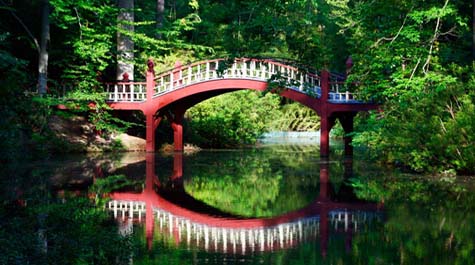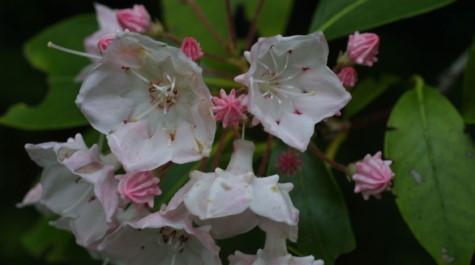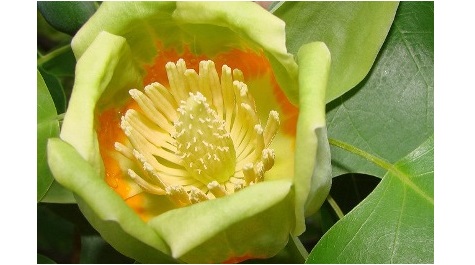Crim Dell
Plans in the early 1960s called for building a new library on the site of Crim Dell. Fortunately President Paschall intervened (Swem Library was instead built at the center of the "New Campus") and later presided over the official dedication of Crim Dell in May 1966. The area is named in memory of John W.H. Crim 1901, "who loved the College." The Crim Dell Bridge was a gift from the Class of 1964. According to campus lore, two people crossing the bridge while holding hands will be lifelong friends; and if they kiss, lifelong lovers.
As you follow the path to the bridge, note the many natural mountain laurels (Kalmia latifolia) that present a spectacular display of blooms in May. These are mixed in with the many cultivated azaleas and beach trees (Fagus grandifolia) whose carvings attest to generations of student romances. As you enter the bridge, a large and stately tulip poplar (Liriodendron tulipifera) welcomes you on your left. Perhaps you have not looked closely at tulip tree flowers because they are often too high to see until they fall. They are beautiful and bear strong resemblance to Magnolias which are close cousins. Tulip poplars are also very important trees for our native pollinators as they produce abundant pollen and nectar. There is much to discover, even about a common tree. A new study discovered a novel antibiotic in the nectar which keeps the nectar from spoiling in the heat.
Cross the bridge carefully because you may not be accustomed to the sloping walkway.
When you reach the other side, other native plants greet you. On your right, one of our most common oaks, the white oak (Quercus alba) is naturally growing. The lobes on its leaves are rounded, and the mature bark is pale grey with a shredding appearance. White oaks have very hard and important wood for woodworking. The tradeoff for such hard wood is that they are very slow growing. On your left are large specimens of yaupon holly (Ilex vomitoria). The scientific name derives from the native American use of the plant as an emetic and ceremonial tea. It can be a thicket forming shrub tolerating wet soils very well. Therefore, it would make an excellent planting for a rain garden, and the berries are an important food source for wildlife.
The eastern end of the Dell formerly contained bamboo, which has been removed to re-vegetate the area and showcase native plants. It is a work in progress. As you follow the path toward the wildflower refuge, note the many azaleas, camellias and laurels along the way. At the west end of the Dell in the water, look for the 4-foot bronze sculpture "Great Blue Heron with Marsh Wren and Turtle" made by David H. Turner '83 and donated to the College by Ben Field '57. It features cattails and a turtle on the base. Originally installed on land beside the water, the statue went missing after Hurricane Ernesto (2006) and was found at the bottom of Crim Dell. Biology Professor Mathes, consulted on the statue's re-installation, recommended a location in the water at least "one student's-body length from the shore."



















